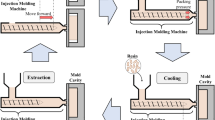Abstract
The design of the runner and gating systems is of great importance to achieving a successful injection moulding process. The subjects of this study are the finite element and abductive neural network methods applied to the analysis of a multi-cavity injection mould. In order to select the optimal runner system parameters to minimize the warp of an injection mould, FEM, Taguchi’s method and an abductive network are used. These methods are applied to train the abductive neural network. Once the runner and gate system parameters are developed, this network can be used to accurately predict the warp of the multi-injection mould. A simulated annealing (SA) optimization algorithm with a performance index is then applied to the neural network in order to search the gate and runner system parameters. This method obtains a satisfactory result as compared with the corresponding finite element verification.
Similar content being viewed by others
References
Li CS, Shen YK (1995) Optimum design runner system balancing in injection moulding. Int Commun Heat Mass Transf 22(2):179–188
Sulaiman S, Keen TC (1997) Flow analysis along the runner and gating system of a casting process. J Mater Process Technol 63:690–695
Hu BH, Tong KK, Niu XP, Pinwill I (2000) Design and optimization of runner and gating systems for the die casting of thin-wall magnesium telecommunication parts through numerical simulation. J Mater Process Technol 105:128–133
Lin JC (2001) Optimum gate design of free-form injection mould using the abductive network. Int J Adv Manuf Technol 17:294–304
Jong WR, Wang KK (1990) Automatic and optimal design of runner systems in injection moulding based on the flow simulation. SPE Annual Technical Conference, pp 554–560
Montgomery GJ, Drake KC, Abductive reasoning network. Neurocomputing 2:97–104
Mouldflow Corporation (2001) Moldflow course map, basic modeling, mesh editing and post processing, version 3.1. Mouldflow Corporation, USA
Kirkpartick S, Gelatt CD, Vecchi MP (1983) Optimization by simulated annealing. Science 220:671–680
Ivakhnenko AG (1971) Polynomial theory of complex system. IEEE Trans Syst Man Cybern 1(4):364–378
Barron AR (1984) In: Farlow SJ(ed) Predicted square error: a criterion forautomatic model selection, self-organizing methods in modeling: GMDH type algorithms. Dekker, New York
Metropolis N, Rosenbluth A, Rosenbluth M, Teller A, Teller E (1953) Equation of state calculation by fast computing machines. J Chem Phys 21:1087–1092
Author information
Authors and Affiliations
Corresponding author
Rights and permissions
About this article
Cite this article
Lee, K., Lin, J. Design of the runner and gating system parameters for a multi-cavity injection mould using FEM and neural network. Int J Adv Manuf Technol 27, 1089–1096 (2006). https://doi.org/10.1007/s00170-004-2287-0
Received:
Accepted:
Published:
Issue Date:
DOI: https://doi.org/10.1007/s00170-004-2287-0




